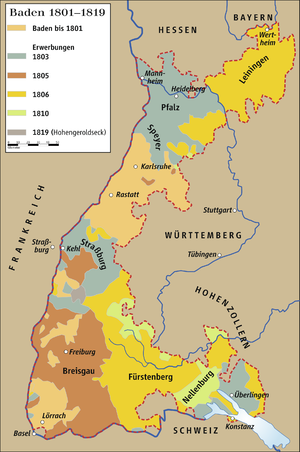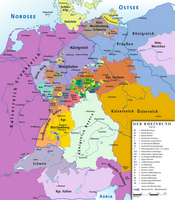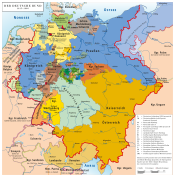This is an old revision of this page, as edited by Jack Bufalo Head (talk | contribs) at 23:36, 12 October 2012. The present address (URL) is a permanent link to this revision, which may differ significantly from the current revision.
Revision as of 23:36, 12 October 2012 by Jack Bufalo Head (talk | contribs)(diff) ← Previous revision | Latest revision (diff) | Newer revision → (diff)| It has been suggested that Baden be merged into this article. (Discuss) Proposed since October 2012. |
| Grand Duchy of BadenGroßherzogtum Baden | |||||||||
|---|---|---|---|---|---|---|---|---|---|
| 1806–1918 | |||||||||
 Flag (1891–1918)
Flag (1891–1918)
 Coat of arms
Coat of arms
| |||||||||
| Anthem: Badnerlied | |||||||||
 The Grand Duchy of Baden on a section of the Travel Map of Germany from 1861 The Grand Duchy of Baden on a section of the Travel Map of Germany from 1861 | |||||||||
 Baden, shown within the German Empire Baden, shown within the German Empire | |||||||||
| Capital | Karlsruhe | ||||||||
| Common languages | Alemannic German | ||||||||
| Religion | Protestant (after reunification in 1771) | ||||||||
| Government | Monarchy | ||||||||
| Grand Duke of Baden | |||||||||
| • 1771–1811 (first grand duke) | Charles Frederick | ||||||||
| • 1907–18 (last grand duke) | Friedrich II (died 1928) | ||||||||
| Staatsminister | |||||||||
| • 1809–10 (first) | Sigismund von Reitzenstein | ||||||||
| • 1917–18 (last) | Heinrich von und zu Bodman | ||||||||
| Legislature | Landtag | ||||||||
| • Upper house | Erste Kammer | ||||||||
| • Lower house | Zweiten Kammer | ||||||||
| History | |||||||||
| • Margraviate raised to grand duchy | 1806 | ||||||||
| • Joined German Emp. | 1871 | ||||||||
| • German Revolution | November 14 1918 | ||||||||
| Area | |||||||||
| 1803 | 3,400 km (1,300 sq mi) | ||||||||
| 1905 | 15,082 km (5,823 sq mi) | ||||||||
| Population | |||||||||
| • 1803 | 210,000 | ||||||||
| • 1905 | 2,009,320 | ||||||||
| Currency |
| ||||||||
| |||||||||
| a: Karl Friedrich was Margrave of Baden-Durlach from 1746–71, when he inherited Baden-Baden, becoming Margrave of unified Baden. In 1803, support for Napoleon saw him raised to Elector of Baden. He joined the Confederation of the Rhine in 1806, when he was raised to Grand Duke of Baden. | |||||||||
The Grand Duchy of Baden (Template:Lang-de) was a historical state in the southwest of Germany, on the east bank of the Rhine. It existed between 1806 and 1918.
History
Main article: History of BadenBaden came into existence in the 12th century as the Margraviate of Baden and subsequently split into different lines, which were unified in 1771. In 1803 Baden was raised to Electoral dignity within the Holy Roman Empire. Baden became the much-enlarged Grand Duchy of Baden through the dissolution of the Holy Roman Empire in 1806. In 1815 it joined the German Confederation. During the Revolutions of 1848 in the German states, Baden was a center of revolutionist activities. In 1849 it was the only German state that became a republic for a short while, under the leadership of Lorenzo Brentano. Finally the revolution in Baden was suppressed mainly by Prussian troops.
The Grand Duchy of Baden remained a sovereign country until it joined the German Empire in 1871. After the revolution of 1918 Baden became part of the Weimar Republic as the Republic of Baden.
Constitution and Government

The Grand Duchy of Baden was a hereditary monarchy with executive power vested in the Grand Duke, while the legislative authority was shared by him with a representative assembly (Landtag) consisting of two chambers.
The upper chamber included all the princes of the ruling family of full age, the heads of all the mediatized families, the Archbishop of Freiburg, the president of the Protestant Evangelical Church, a deputy from each of the universities and the technical high school, eight members elected by the territorial nobility for four years, three representatives elected by the chamber of commerce, two by that of agriculture, one by the trades, two mayors of municipalities, and eight members (two of them legal functionaries) nominated by the Grand Duke.
The lower chamber consisted of 73 popular representatives, of whom 24 were elected by the burgesses of certain communities, and 49 by rural communities. Every citizen of 25 years of age, who had not been convicted and was not a pauper, had a vote. The elections were, however, indirect. The citizens selected the Wahlmänner (deputy electors), the latter selecting the representatives. The chambers met at least every two years. The lower chambers were elected for four years, half the members retiring every two years.
The executive consisted of four departments: The interior, foreign and grand-ducal affairs, finance, and justice, and ecclesiastical affairs and education.
The chief sources of revenue were direct and indirect taxes, the railways and domains. The railways were operated by the state, and formed the only source of major public debt, about 22 million pounds sterling.
The supreme courts lay in Karlsruhe, Freiburg, Offenburg, Heidelberg, Mosbach, Waldshut, Konstanz, and Mannheim, whence appeals passed to the Reichsgericht (the supreme tribunal) in Leipzig.
Grand Dukes of Baden
- 1806–1811: Charles Frederick (* 1728; † 1811)
- 1811–1818: Charles (* 1786; † 1818)
- 1818–1830: Louis I (* 1763; † 1830)
- 1830–1852: Leopold (* 1790; † 1852)
- 1852–1858: Louis II (* 1824; † 1858)
- 1858–1907: Frederick I (* 1826; † 1907), (since 1852 Regent, since 1856 with the title Grand Duke)
- 1907–1918: Frederick II (* 1857; † 1928)
Minister of state 1809–1918
- 1809–1810: Sigismund von Reitzenstein
- 1810–1810: Conrad Karl Friedrich von Andlau-Birseck
- 1810–1812: Christian Heinrich Gayling von Altheim
- 1812–1817: Karl Christian von Berckheim
- 1817–1818: Sigismund von Reitzenstein
- 1818–1831: Wilhelm Ludwig Leopold Reinhard von Berstett
- 1832–1833: Sigismund von Reitzenstein
- 1833–1838: Ludwig Georg von Winter
- 1838–1839: Karl Friedrich Nebenius
- 1839–1843: Friedrich Landolin Karl von Blittersdorf
- 1843–1845: Christian Friedrich von Boeckh
- 1845–1846: Karl Friedrich Nebenius
- 1846–1848: Johann Baptist Bekk
- 1848–1849: Karl Georg Hoffmann
- 1849–1850: Friedrich Adolf Klüber
- 1850–1856: Ludwig Rüdt von Collenberg-Bödigheim
- 1856–1860: Franz von Stengel
- 1861–1866: Anton von Stabel
- 1866–1868: Karl Mathy
- 1868–1876: Julius Jolly
- 1876–1893: Ludwig Karl Friedrich Turban
- 1893–1901: Franz Wilhelm Nokk
- 1901–1905: Carl Ludwig Wilhelm Arthur von Brauer
- 1905–1917: Alexander von Dusch
- 1917–1918: Heinrich von Bodman
External links
 Texts on Wikisource:
Texts on Wikisource:
- Encyclopædia Britannica (11th ed.). 1911.
{{cite encyclopedia}}: Missing or empty|title=(help) - Ripley, George; Dana, Charles A., eds. (1879). The American Cyclopædia.
{{cite encyclopedia}}: Missing or empty|title=(help) - Baynes, T. S., ed. (1878). Encyclopædia Britannica. Vol. 3 (9th ed.). New York: Charles Scribner's Sons.
{{cite encyclopedia}}: Missing or empty|title=(help)
- Encyclopædia Britannica (11th ed.). 1911.
| States of the Confederation of the Rhine (1806–1813) | ||||||||
|---|---|---|---|---|---|---|---|---|
| Rank elevated by Napoleon |
|  | ||||||
| States created |
| |||||||
| Pre-existing states |
| |||||||
| ||||||||
| States of the German Confederation (1815–1866) | |||||||||
|---|---|---|---|---|---|---|---|---|---|
| Empires |  | ||||||||
| Kingdoms | |||||||||
| Electorates | |||||||||
| Grand duchies | |||||||||
| Duchies |
| ||||||||
| Principalities |
| ||||||||
| Free cities | |||||||||
| |||||||||
| States of the German Empire (1871–1918) | ||
|---|---|---|
| Kingdoms |
|  |
| Grand Duchies | ||
| Duchies | ||
| Principalities | ||
| City-states | ||
| Imperial Territories | ||
| Other | ||
49°1′N 8°24′E / 49.017°N 8.400°E / 49.017; 8.400
Categories: